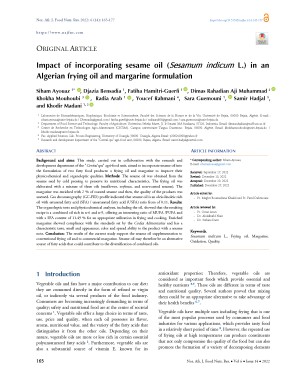Main Article Content
Impact of incorporating sesame oil (Sesamum indicum L.) in an Algerian frying oil and margarine formulation
Abstract
Background and aims: This study, carried out in collaboration with the research and development department of the "Cevital spa" agri-food unit, aimed to incorporate sesame oil into the formulation of two fatty food products: a frying oil and margarine to improve their physicochemical and organoleptic qualities. Methods: The sesame oil was obtained from the sesame seed by cold pressing to preserve its nutritional characteristics. The frying oil was elaborated with a mixture of three oils (sunflower, soybean, and non-roasted sesame). The margarine was enriched with 2 % of roasted sesame and then, the quality of the products was assessed. Gas chromatography (GC-FID) profile indicated that sesame oil is an oleic-linoleic rich oil with saturated fatty acid (SFA) / unsaturated fatty acid (USFA) ratio from of 0.11. Results: The organoleptic tests and physicochemical analyses, including the oil, showed that the resulting recipe is a combined oil rich in n-6 and n-9, offering an interesting ratio of MUFA /PUFA and with a SFA content of 11.49 % for an appropriate utilization in frying and cooking. Enriched margarine showed compliance with the standards set by the Codex Alimentarius and has a characteristic taste, smell and appearance, color and spread ability to the product with a sesame note. Conclusion: The results of the current study support the sesame oil supplementation to conventional frying oil and to commercial margarine. Sesame oil may therefore be an alternative source of fatty acids that could contribute to the diversification of combined oils.







